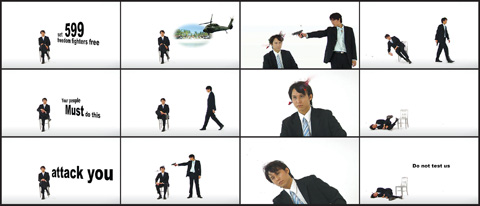The Taishin Art Awards (台新藝術獎) ceremony was held on Saturday at Taishin Bank’s slick new office tower on Renai circle. Tsui Kuang-yu’s (崔廣宇) video installation The Shortcut to the Systematic Life — Invisible City (系統生活捷徑 — 城市瞎摸) picked up the top prize in the visual art category.
The Taishin Bank Foundation for Arts and Culture (台新銀行文化藝術基金會) handed out NT$1 million in cash prizes in two categories. The prizes are only small brush strokes on a large canvas that seeks to show off some of Taiwan’s best contemporary art.
Becky Cho (曹鸞姿), the foundation’s director, said Tsui is representative of Taiwan’s contemporary artists because he is young, works in new media and is adept at networking.

PHOTO COURTESY OF MOCA, TAIPEI
“It takes a lot to be an artist now,” Cho said. “The art environment has become more than just point-to-point. It’s more like a web. You don’t just own a studio or show your work once a year and just talk to one guy that is your agent. You really have to go out and meet people and do a lot of networking.”
Cho said that networking determines, to a large extent, how the awards’ international jury is chosen.
The jury is made up of three groups. The judging process begins with a “nominating committee,” which is a group made up of local reporters, critics and academics that frequent galleries, museums and festivals across the island. This “frontline group,” as Cho calls it, reports back to a “review committee” every three months, which whittles down contenders and produces a shortlist that is passed on to the international jury.
Cho said international jurors are selected on their ability to promote Taiwanese art abroad. Cho networks with local foreign institutes in Taiwan and seeks their input in choosing the international jurors.
“We want [international jurors] to come to Taiwan to pick work that they think they could bring to their own country,” she said.
Two other rules determine the composition of the jury. The first is that the international jurors should have never been to Taiwan. This ensures that the awards introduces Taiwanese contemporary art to new audiences. The other is that the festival directors should not be attached to a mainstream institution, which is conducive to promoting more radical contemporary art.
“These works push the envelope and are not mainstream … . I have found there is a trend of encouraging edgy work and even underground work — work that would not necessarily be promoted otherwise,” Cho said.
The Taishin Art Awards includes a performance art category. Horse Dance Theater (驫舞劇場) took top honors with Velocity (速度), a work that investigates through movement the frenetic pace of contemporary urban life. Further information about short-listed nominees can be found at www.taishinart.org.tw.

In the March 9 edition of the Taipei Times a piece by Ninon Godefroy ran with the headine “The quiet, gentle rhythm of Taiwan.” It started with the line “Taiwan is a small, humble place. There is no Eiffel Tower, no pyramids — no singular attraction that draws the world’s attention.” I laughed out loud at that. This was out of no disrespect for the author or the piece, which made some interesting analogies and good points about how both Din Tai Fung’s and Taiwan Semiconductor Manufacturing Co’s (TSMC, 台積電) meticulous attention to detail and quality are not quite up to

April 21 to April 27 Hsieh Er’s (謝娥) political fortunes were rising fast after she got out of jail and joined the Chinese Nationalist Party (KMT) in December 1945. Not only did she hold key positions in various committees, she was elected the only woman on the Taipei City Council and headed to Nanjing in 1946 as the sole Taiwanese female representative to the National Constituent Assembly. With the support of first lady Soong May-ling (宋美齡), she started the Taipei Women’s Association and Taiwan Provincial Women’s Association, where she

Chinese Nationalist Party (KMT) Chairman Eric Chu (朱立倫) hatched a bold plan to charge forward and seize the initiative when he held a protest in front of the Taipei City Prosecutors’ Office. Though risky, because illegal, its success would help tackle at least six problems facing both himself and the KMT. What he did not see coming was Taipei Mayor Chiang Wan-an (將萬安) tripping him up out of the gate. In spite of Chu being the most consequential and successful KMT chairman since the early 2010s — arguably saving the party from financial ruin and restoring its electoral viability —

It is one of the more remarkable facts of Taiwan history that it was never occupied or claimed by any of the numerous kingdoms of southern China — Han or otherwise — that lay just across the water from it. None of their brilliant ministers ever discovered that Taiwan was a “core interest” of the state whose annexation was “inevitable.” As Paul Kua notes in an excellent monograph laying out how the Portuguese gave Taiwan the name “Formosa,” the first Europeans to express an interest in occupying Taiwan were the Spanish. Tonio Andrade in his seminal work, How Taiwan Became Chinese,